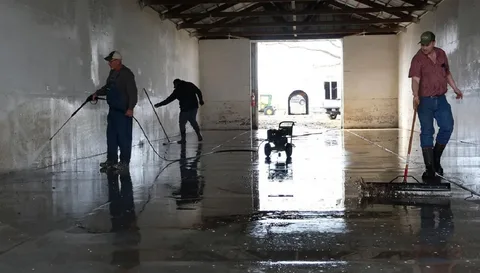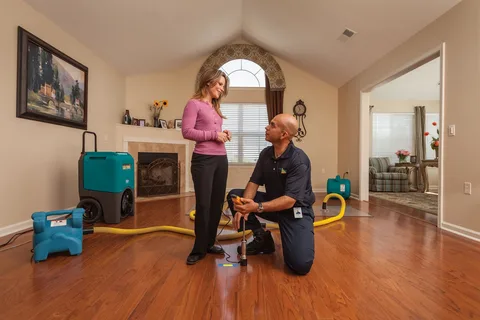When flood damage Central Coast strikes, it is essential to remain calm and take action quickly. While flooding can cause devastating consequences to homes and businesses, a well-thought-out plan of action can help mitigate the destruction. In this blog post, we will discuss the top strategies to employ in an emergency situation so you can manage the effects of a flood as efficiently as possible. Read on to find out more about how to protect yourself and your property from flood damage Central Coast.
Assessing the Damage
After a flood, it’s crucial to assess the damage as quickly as possible. This step will help you determine the extent of the destruction and enable you to prioritize your next actions. Begin by carefully inspecting your property, both inside and out.
Start by checking for any immediate hazards, such as structural damage or standing water. If you notice any significant cracks, sagging walls, or other signs of instability, it’s essential to evacuate the premises immediately and seek professional help.
Once you’ve ensured your safety, take photographs or videos of the damage. These visuals will serve as valuable evidence for insurance purposes and help expedite the claims process. Pay close attention to any destroyed belongings, structural issues, or other visible damages.
Next, take note of any water-related damage, such as mold growth or moisture saturation. These can lead to long-term issues if not addressed promptly. If possible, try to salvage any valuable items and move them to a dry location to prevent further damage.
Assessing the damage can be overwhelming, but it’s an essential step in managing flood damage. By staying calm and methodically evaluating the situation, you can better understand the scope of the destruction and take appropriate action to mitigate further harm.
Staying Safe
During a flood, it is essential to prioritize your safety above all else. The safety of yourself and your loved ones should always be the number one concern in an emergency situation. When flood damage strikes the Central Coast, it’s crucial to follow these guidelines to stay safe:
- Evacuate if necessary: If you notice any significant structural damage or standing water, evacuate the premises immediately. Seek higher ground or a designated evacuation center for your safety.
- Avoid contact with floodwater: Floodwater can be contaminated with various pollutants and can pose health risks. Avoid contact with floodwater as much as possible. If you do come into contact with it, wash thoroughly with clean water and soap.
- Beware of electrical hazards: Floodwater can cause electrical appliances and outlets to become a safety hazard. If you suspect any electrical issues, turn off the main power supply and contact a professional electrician.
Remember, your safety is of utmost importance during a flood. By following these guidelines, you can ensure the well-being of yourself and your loved ones in an emergency situation.
 Contacting Emergency Services
Contacting Emergency Services
In the event of a flood, it’s crucial to contact emergency services as quickly as possible. This step is vital to ensure the safety of yourself and your loved ones and to expedite the assistance you may need. Here’s what you need to do when contacting emergency services for flood damage Central Coast:
- Dial the emergency number: Whether it’s 911 or a specific local emergency number, make sure to dial it promptly. Provide them with accurate information about your situation, including the severity of the flood and any immediate dangers you’re facing.
- Follow instructions: Emergency service operators are trained to guide you through challenging situations. Listen carefully to their instructions and follow them to the best of your ability.
- Provide necessary details: When speaking with emergency services, be prepared to provide specific information about your location, the extent of the flood damage, and any other relevant details that may assist them in their response.
Remember, contacting emergency services is crucial during a flood emergency. Stay calm, be clear in your communication, and trust that help is on the way.
Documenting the Damage for Insurance Purposes
After a flood, one of the most crucial steps is to document the damage for insurance purposes. This documentation will be essential when filing a claim and ensuring that you receive the appropriate compensation for your losses. Here are some tips on how to effectively document the damage:
- Take detailed photographs: Use a camera or your smartphone to capture clear and comprehensive images of the affected areas. Be sure to focus on the extent of the damage, including any destroyed belongings, structural issues, and visible damages.
- Make a list: Create a detailed list of all damaged items, including their value and any relevant receipts or documentation. This will help you provide accurate information to your insurance company when filing a claim.
- Gather evidence: Collect any other relevant evidence, such as videos, receipts, or invoices related to repairs or replacements. This additional documentation can strengthen your claim and provide additional proof of the extent of the damage.
Remember, documenting the damage is an essential step in the recovery process after a flood. By following these tips, you can ensure that you have the necessary evidence to support your insurance claim and receive the compensation you deserve.
Drying Out Your Property
Once you have assessed the damage caused by a flood, the next step is to start drying out your property. Removing excess moisture is essential to prevent further damage and minimize the risk of mold growth. Here are some tips to help you effectively dry out your property after flood damage:
- Open doors and windows: Increase airflow throughout your property by opening doors and windows. This will help facilitate the drying process and improve air circulation.
- Use fans and dehumidifiers: Place fans strategically to promote air movement and aid in drying out wet areas. Additionally, consider using dehumidifiers to remove excess moisture from the air.
- Remove standing water: If there is still standing water, use a pump or a wet/dry vacuum to remove it as quickly as possible. Standing water can cause further damage and increase the risk of mold growth.
Remember, drying out your property after a flood requires patience and persistence. Be thorough in your efforts to remove moisture and keep a close eye on any areas that may still be damp.
Disinfecting Your Home or Business
After a flood, it is crucial to thoroughly disinfect your home or business to ensure the safety and health of everyone in the space. Floodwaters can be contaminated with various bacteria, viruses, and other harmful pathogens, posing serious risks to individuals if not properly addressed. Here are some tips on how to effectively disinfect your property after flood damage:
- Remove debris: Before disinfecting, remove any debris or dirt from the affected areas. This will allow the disinfectant to work more effectively.
- Use a disinfectant solution: Choose a disinfectant that is effective against a wide range of pathogens, including viruses and bacteria. Follow the instructions on the label for dilution ratios and application methods.
- Apply the disinfectant: Use a cloth or sponge to apply the disinfectant solution to all surfaces that came into contact with the floodwater. Pay special attention to areas that are frequently touched, such as doorknobs, light switches, and countertops.
By following these steps, you can effectively disinfect your home or business after flood damage and create a safe environment for everyone. Remember to always prioritize your safety and wear protective gloves and clothing when handling disinfectants.
FAQs
Q: What should I do if I notice cracks or structural damage after a flood?
A: If you notice any significant cracks or signs of instability, it is crucial to evacuate the premises immediately and seek professional help. Your safety should always be the top priority in an emergency situation.
Q: Can I salvage any belongings after a flood?
A: If possible, try to salvage any valuable items and move them to a dry location to prevent further damage. However, prioritize your safety and only attempt salvage operations if it is safe to do so.
Q: What should I do if I come into contact with floodwater?
A: Floodwater can be contaminated with various pollutants and can pose health risks. If you do come into contact with it, wash thoroughly with clean water and soap to minimize the risk of infection.
Conclusion
In times of flood damage on the Central Coast, it’s crucial to remain calm, act quickly, and implement the strategies discussed in this blog post. Assessing the damage is the first step, followed by prioritizing safety and contacting emergency services. Documenting the damage for insurance purposes is essential to ensure appropriate compensation for losses. Once the initial steps are taken, focus on drying out the property and disinfecting the affected areas to prevent further damage and ensure the safety of everyone involved.
Remember, a flood can be overwhelming, but with the right plan and swift action, you can effectively manage the situation. By following the strategies outlined in this blog post, you can mitigate the destruction caused by flood damage on the Central Coast and protect yourself and your property. Stay safe, be prepared, and act fast – your proactive approach will make all the difference in overcoming the challenges of flood damage.
| Other Good Articles to Read |
| Blogs-Nation |
| Blogs-Peoples |
| Bryan Smith Blogs |
| Intellect Blogs |
| The Fault In Our Blogs |
| Blogs Eu |
| Oz Forums |
| Recruitment Blogs |
| Zet Blogs |
| Id Blogs |
| Blogs Tudiolegale |
| Blogs Map |



